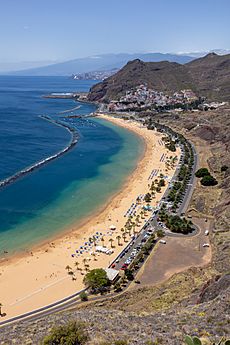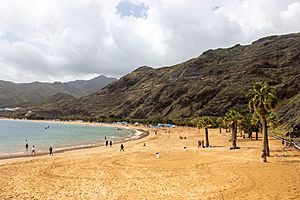Playa de Las Teresitas facts for kids
Quick facts for kids Playa de Las Teresitas |
|
|---|---|
| Location | Santa Cruz de Tenerife |
| Coordinates | 28°30′31″N 16°11′09″W / 28.50861°N 16.18583°W |
The Playa de Las Teresitas is a famous beach in Tenerife, Spain. It's special because it's an artificial beach with beautiful white sand, unlike most beaches in the Canary Islands which have black volcanic sand. You can find it north of the village of San Andrés, near Santa Cruz de Tenerife.
Contents
What the Beach Was Like Before
Before the new beach was built, this area looked very different. It was mostly made of stones and rocks, with only a small strip of natural black sand. This original beach was divided into three parts, each with its own name: Tras la Arena, Los Moros, and the area near the Las Teresas ravine.
There was even a private spa in the middle of the beach. People also used to go surfing there. Above the beach, there were farms and orchards. They grew fruits and vegetables like bananas, mangoes, tomatoes, and avocados. These farms provided most of the income for the nearby town at that time.
There is also an important paleontological site here. It's a special underwater area where scientists have found fossil mollusks (like ancient shells). Some of these fossils are unique to this place.
How the New Beach Was Built
In the 1950s, many beaches in the Santa Cruz area started to disappear. Their sand was being used for construction, and the Port of Santa Cruz de Tenerife was getting bigger. Because of this, the Ayuntamiento de Santa Cruz de Tenerife (Santa Cruz City Council) started thinking about building an artificial beach in San Andrés in 1953.
The first plan was approved in 1961. Engineers Pompeyo Alonso and Miguel Pintor then created a full design for the new beach. The city council approved their design in 1965, and the Spanish government approved it in 1967.
To make the beach wider (about 80 metres (260 ft)), the farms above the beach had to be bought by the government. Parts of the land, including a section of the ravine, also had to be lowered.
In 1968, a long wall called a breakwater was built. It was placed about 150 metres (490 ft) from the shore and was 1 kilometre (0.62 mi) long. Two piers and an underwater step were also built. These structures help stop big waves from carrying the sand out to sea. They also make the beach safer for people who want to swim.
The beach is about 1.3 kilometres (0.81 mi) long. At the time, buying black sand from the local area was too expensive because there wasn't much of it. So, officials looked into importing white sand from the Sahara Desert. White sand was also more attractive to tourists.
In 1971, the city council got a loan of 50 million pesetas. They bought 150,000 cubic meters of sand, which weighed around 270,000 tons. This sand came from the El Aaiún region in the Western Sahara. A company called Fosfatos de Bucraa transported the sand. Five million bags of sand arrived on a ship called Gopegui.
This imported sand was used to fill the beach in the first half of 1973. The new artificial white sand beach officially opened on June 15, 1973. At first, there were some small problems because red ants and scorpions were accidentally brought in with the sand. The beach's current kiosks were also built around this time.
Keeping the Beach Beautiful
The white sand at Las Teresitas is lighter than the natural black sand. This means the wind can pick up the grains more easily and blow them off the beach. The changes made to the ravine during construction also increased the local wind speed, making this problem worse.
The breakwater helps by reducing how much sand is removed by waves. However, it also means that waves don't bring in new sand to replace what's lost. Not much sand is washed away by rain because the area doesn't get much rainfall. But people using the beach can also cause sand to be lost. The beach is regularly cleaned and smoothed to keep it looking nice.
Between April and November 1998, another 2,800 tonnes of Saharan sand were added to the beach. This was done to replace the sand that had been lost during the beach's first 25 years. This new sand cost 400 million pesetas.
What People Do at the Beach
Playa de Las Teresitas is one of the most popular beaches in the Canary Islands. It's special because it doesn't have the black, volcanic sand that most other beaches on Tenerife have. Other beaches, like Las Vistas in Los Cristianos, are also artificial. However, the beach at El Médano (the Dune) is completely natural.
The Playa de Las Teresitas was even chosen for a TV commercial for the third season of the reality show, Geordie Shore. The ad was for their "Chaos in Cancún" season, which aired on MTV in the UK.
The beach has parking for over 100 cars and is also served by a bus. It offers a paddle area, bars, restaurants, and other facilities for visitors to enjoy.
See also
 In Spanish: Playa de Las Teresitas para niños
In Spanish: Playa de Las Teresitas para niños



